Cuando alguien pregunta " ¿cuánto tiempo se tarda en aprender a surfear ?", la respuesta suele ser entre unas horas y un mes. No se trata de una simple curiosidad: es la primera ola que cogerás en tu nueva aventura. Tanto si te estás preparando para tu primera lección como si quieres mejorar tus habilidades, este artículo te indicará el tiempo que puedes esperar. Así que, sumerjámonos en el mundo del surf y descubramos cuánto tiempo te puede llevar surfear las olas con confianza y estilo.
¿Qué tan rápido puedes aprender a surfear?
El tiempo necesario para convertirse en un surfista competente puede variar mucho: algunos dominan los conceptos básicos en solo unas horas, mientras que otros pueden tardar hasta un mes, dependiendo de varios factores.
En las primeras lecciones de surf, empezarás aprendiendo a tumbarte sobre la tabla y a mantener el equilibrio. Puede que te lleve un tiempo, desde 30 minutos hasta unas horas, dependiendo de lo rápido que lo domines. Una vez que hayas aprendido el movimiento, aprenderás a remar y a coger olas, lo que puede requerir horas adicionales de práctica y está muy influenciado por tu estado físico.
El salto, en el que pasas de estar tumbado a estar de pie sobre la tabla, suele ser la parte más complicada para los surfistas noveles. Al principio, es normal que te caigas a menudo y que te resulte difícil lidiar con las olas. Pero una vez que domines esta técnica, al igual que sucede con la bicicleta, se convertirá en una habilidad que te durará toda la vida.
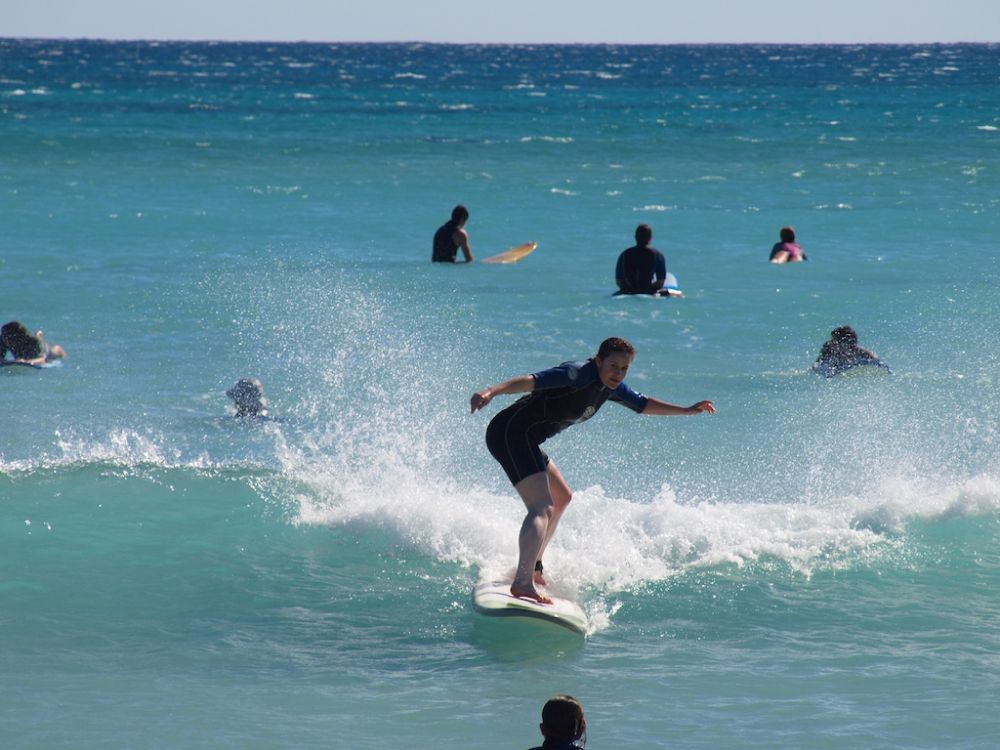
Surfear varias veces por semana puede conducir a un progreso más rápido en comparación con hacerlo sólo los fines de semana.
Tu compromiso, tu estado físico y tu afinidad por los deportes acuáticos juegan un papel importante en la rapidez con la que aprendes a hacer surf. La edad no es un factor significativo: una persona de 60 años en forma puede aprender más rápido que un joven de 16 años menos activo.
En promedio, con una tabla de surf adecuada y dedicación, puedes esperar surfear una ola después de 5 a 20 horas de práctica. La clave es la persistencia, la paciencia y la motivación. Cuanto más surfees y observes a los demás, más rápido mejorarás.
Como principiante en el surf, uno de los primeros obstáculos que enfrentarás es aprender la forma correcta de pararte sobre la tabla. El surf no solo se trata de habilidades físicas, sino también de comprender el mar. La velocidad con la que mejoras depende de los tipos de olas que surfees, tu habilidad para nadar, tu conocimiento del océano y de tener el equipo adecuado.
¿Estás listo para conquistar las olas y sentir la emoción del surf? Sumérgete en nuestra guía de consejos esenciales Consejos de surf para principiantes . Descubre cómo dominar los conceptos básicos, desde ponerte de pie sobre la tabla hasta leer el ritmo del océano.
¿Cuántas lecciones de surf necesitas?
Al sumergirte en el mundo del surf, probablemente te estés preguntando cuántas lecciones se necesitan para subirse a una tabla de surf y coger esas olas como un profesional. Bueno, en realidad depende de tu nivel de condición física, ya que el camino de cada persona en el surf es único. Simplifiquemos esto con una tabla que te dará una buena idea en función de tu nivel de condición física:
| Nivel de condición física | Subirse al tablero | Montando las olas con confianza |
|---|---|---|
| Menos activo | 3 a 4 clases | 6 a 8 clases |
| Aptitud física promedio | 2 clases | 3 a 4 clases |
| Buena forma | 1 Clase | 2 a 3 clases |
| Fitness de primer nivel | 1 Clase | 2 clases |
Suponiendo que cada clase dura aproximadamente 2 horas, estás aprendiendo en un grupo pequeño (3 a 5 personas).
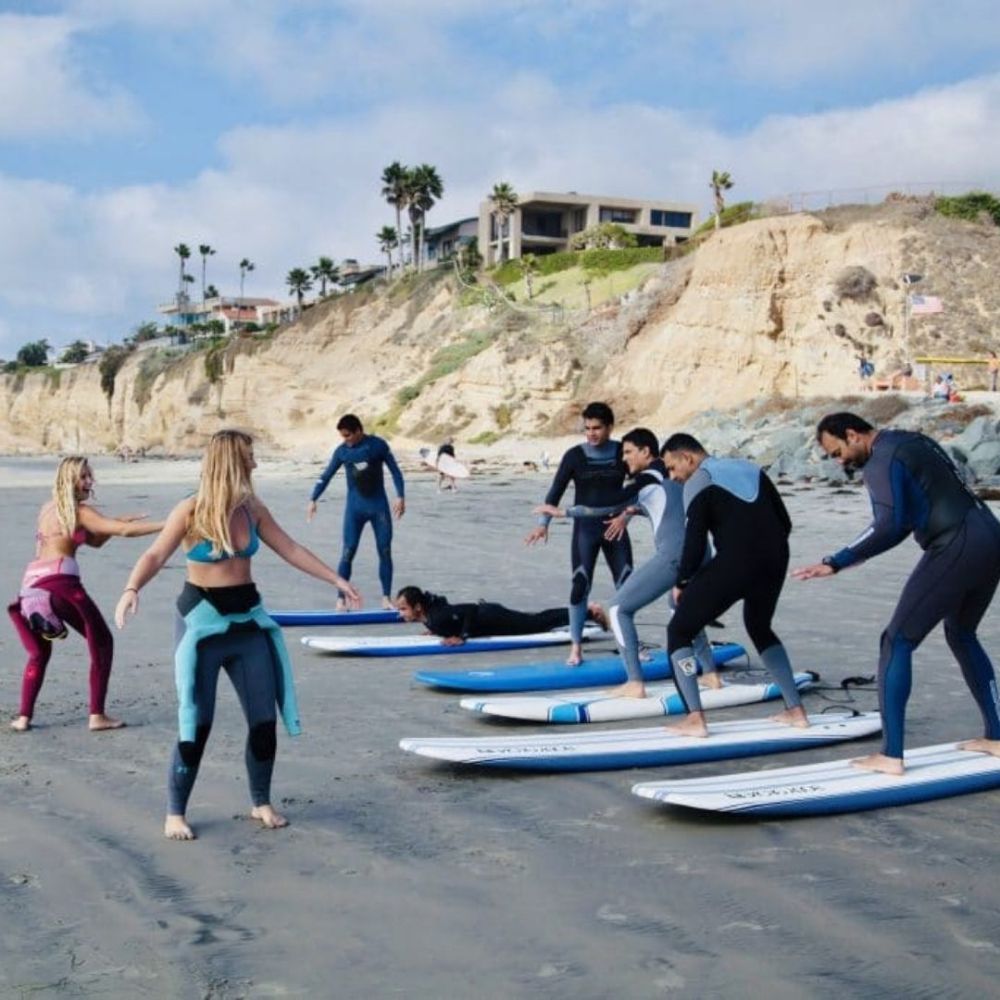
Qué tener en cuenta para las clases de surf
- ¿Quién te está enseñando? Una gran parte de la rapidez con la que aprendes depende de quién te enseñe. Asegúrate de que tu instructor conozca sus habilidades: eso marca una gran diferencia.
- Tamaño de la clase: Las clases más pequeñas significan que recibirás más atención y consejos personalizados, lo que puede acelerar tu aprendizaje.
- Lo que estás usando: Es una buena idea elegir una escuela de surf que preste tablas y trajes de neopreno. De esa manera, podrás probar antes de comprar y aprender con el equipo adecuado.
Elegirás la mejor escuela de surf y establecerás expectativas realistas en función de tu estado físico al aplicar estos consejos. ¡Hazlos bien y en poco tiempo estarás surfeando por las olas!
La curva de aprendizaje del surf
¿Cuánto tiempo se tarda en aprender a surfear bien? Depende en gran medida de tu dedicación y de la frecuencia con la que practiques. A continuación, te mostramos las etapas y los plazos típicos de la curva de aprendizaje del surf para un principiante absoluto que aspira a convertirse en un surfista intermedio:
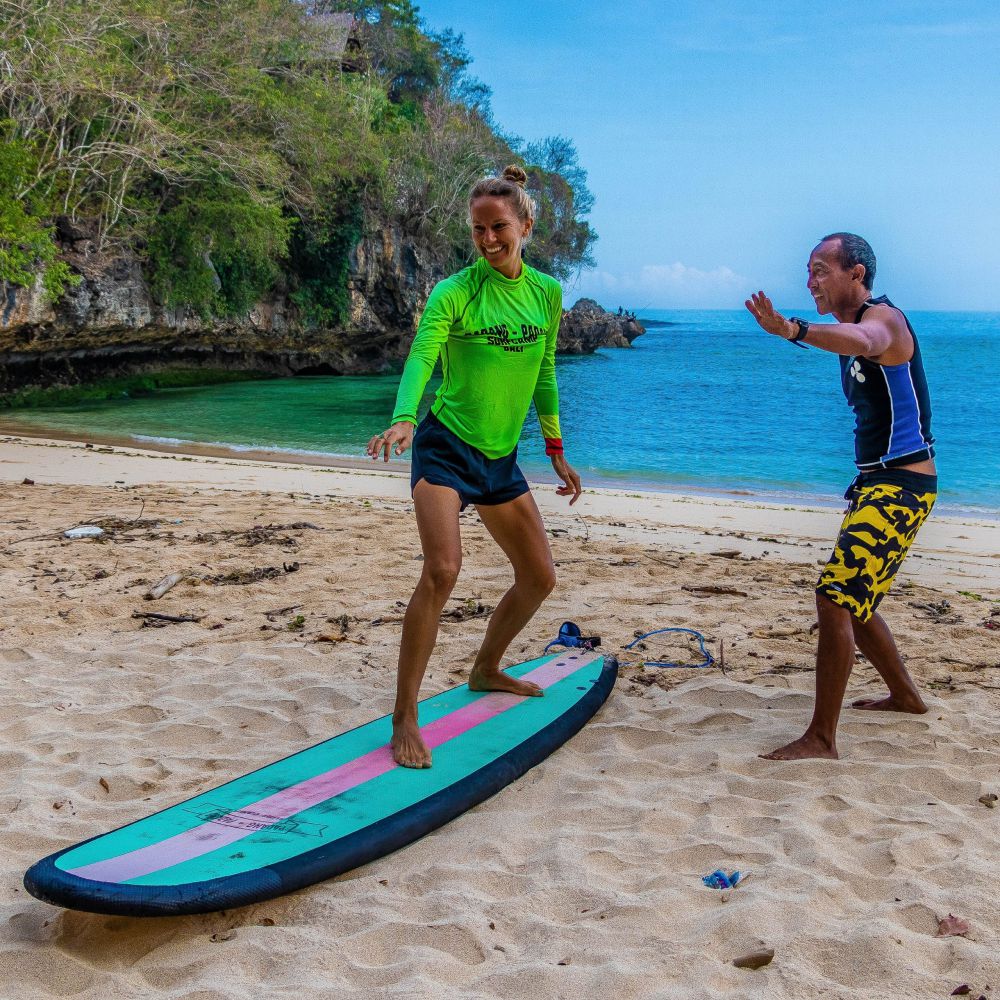
Etapa inicial (2-4 semanas)
- Enfocar: Ponte cómodo en el océano.
-
Habilidades a desarrollar:
- Mejora la natación estilo libre para estar fuerte y relajado.
- Aprenda técnicas seguras de manejo de escombros.
- Practique el buceo de pato adecuado para remar entre las olas rompientes.
- Desarrollar resistencia para remar.
Captura de olas verdes ininterrumpidas (1-3 semanas)
- Enfocar: Empezar a interactuar con ondas ininterrumpidas.
-
Habilidades a desarrollar:
- Identificar zonas adecuadas para principiantes en surf.
- Calcula la velocidad de tu remo para que coincida con la de la ola.
- Practica el salto hacia arriba con la postura de rodillas dobladas.

Montar en cal rota (2-6 semanas)
- Enfocar: Atrapa y monta olas más simples.
-
Habilidades a desarrollar:
- Navega sobre olas blandas y desmenuzadas hacia la orilla.
- Aprenda a controlar la velocidad inclinando la tabla.
- Conseguir estabilidad al permanecer de pie durante el recorrido.
Surfeando olas verdes ininterrumpidas (de 6 semanas a 5 meses)
- Enfocar: Afronta olas más desafiantes.
-
Habilidades a desarrollar:
- Determinar los mejores puntos de despegue en función de la curvatura de la ola.
- Adapte la velocidad de su tabla al oleaje ininterrumpido mientras rema.
- Domina un rápido salto hacia arriba antes de que la ola rompa.
Desarrollo del estilo (de 6 meses a 2 años)
- Enfocar: Perfecciona y personaliza tu estilo de navegación.
-
Habilidades a desarrollar:
- Mejora el equilibrio para recortar y maniobrar en la ola.
- Perfeccione una transición suave para ponerse de pie desde el elemento emergente.
- Aprenda técnicas avanzadas como el tallado, el nose riding y los cutbacks.
Para un principiante absoluto, progresar hasta un nivel intermedio suele llevar entre 6 meses y 1 año con práctica regular. Sin embargo, dominar verdaderamente el surf es un viaje continuo que dura años y evoluciona constantemente con la experiencia y la práctica.
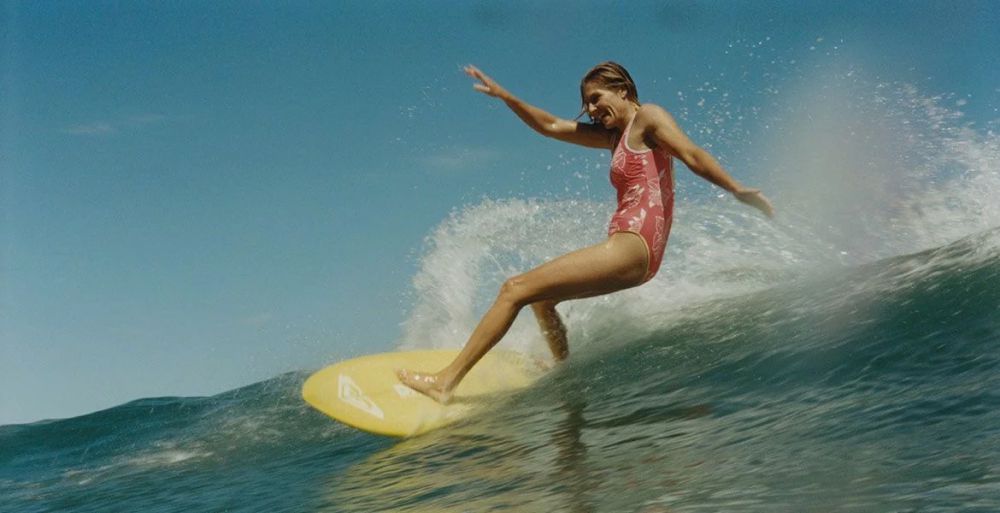
Factores que influyen en la curva de aprendizaje
A medida que comienzas tu viaje de surf y te preguntas Cómo mejorar en el surf para principiantes : es hora de reconocer los diversos factores que pueden afectar su curva de aprendizaje.
- Aptitud física: Tu nivel general de condición física afecta significativamente tu capacidad para aprender a surfear.
- Coherencia en la práctica: Cuanto más tiempo pases practicando en el agua, más rápido mejorarás. La constancia ayuda a desarrollar la memoria muscular y a perfeccionar tu técnica.
- Calidad de la instrucción: Contar con un instructor experto y experimentado que pueda brindarle retroalimentación personalizada y corregir sus errores en tiempo real.
- Condiciones de surf: El tipo de olas en las que se practica es importante. Los principiantes suelen progresar más rápido en olas más pequeñas y manejables, donde pueden practicar los conceptos básicos de forma segura.
- Equipo utilizado: Los principiantes deben comenzar con tablas más grandes y estables que les permitan mantener el equilibrio y atrapar olas con mayor facilidad.
- Actitud mental: Una actitud positiva y resiliente ayuda a superar los desafíos y las frustraciones que conlleva aprender algo nuevo.
- Entorno de aprendizaje: Un entorno de aprendizaje que te brinde apoyo y aliento puede mejorar tu progreso. Practicar surf con amigos o en una comunidad puede brindarte motivación y consejos útiles.
- Adaptabilidad y estilo de aprendizaje: Cada persona tiene un estilo de aprendizaje diferente. Ser adaptable y estar abierto a probar diferentes técnicas puede ayudarte a encontrar la que funcione mejor para ti.
- Edad y flexibilidad: Si bien el surf se puede aprender a cualquier edad, los surfistas más jóvenes pueden aprender rápidamente debido a su agilidad natural, pero los surfistas mayores a menudo aportan una valiosa paciencia al proceso de aprendizaje.
El viaje para convertirse en experto en surf es tan gratificante como desafiante, y abrazar cada paso es parte de la aventura.
¿Quieres mejorar tus habilidades de surf? Echa un vistazo a los mejores ejercicios de surf Destinado a mejorar tu fuerza y equilibrio para practicar surf.
¿Cómo mejorar el surf más rápido?
Mejorar tus habilidades de surf y reducir el tiempo que lleva hacerlo bien implica algo más que una práctica frecuente. Incorporar consejos de entrenamiento específicos puede acelerar significativamente tu progreso. Aquí tienes una lista de estrategias para mejorar tus habilidades de surf:
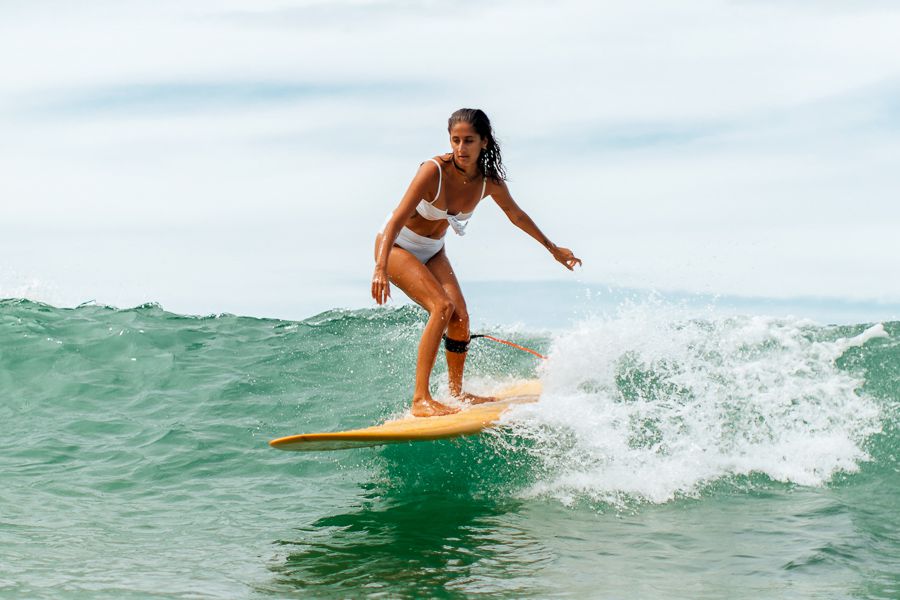
- Filmate mientras surfeas: Una excelente manera de ver qué estás haciendo bien o mal es pedirle a alguien que grabe tus sesiones en video. Luego, puedes observarlas y señalar áreas en las que puedes mejorar.
- Estírate primero: Relájate con algunos estiramientos antes de lanzarte a las olas.
- Comience con ondas suaves: Practica el pop-up con olas más suaves. Es una forma relajada de dominarlo sin demasiada presión.
- Visualiza tu éxito: Imagínate atrapando y surfeando olas en tu mente.
- Mejora gradualmente tus movimientos: Comience por dominar la remada y luego agregue lentamente maniobras más complejas a medida que se sienta cómodo.
- Trabaja en el ritmo de tus olas: Pasa la primera parte de tu sesión de surf remando junto a olas intactas. Es una buena manera de aprender a leer las olas y a controlar el ritmo.
- Utilice su núcleo: Activa los músculos centrales mientras remas. Es cuestión de fuerza en los brazos; la fuerza de tu núcleo puede realmente aumentar tu velocidad.
- Habilidades de seguridad: Asegúrate de estar al día con Seguridad en el surf , como por ejemplo cómo utilizar la correa correctamente, lo que puede evitarte problemas.
- Mira y aprende: Presta atención a otros surfistas, especialmente a los profesionales. Puedes aprender mucho simplemente observando sus movimientos y técnicas.
- Sea inteligente con su entrenamiento: Planifique sus sesiones de práctica con un objetivo claro. Trabajar en una sola habilidad a la vez puede llevar a un dominio más rápido y mejor de la misma.
Si quieres llevar tu surf al siguiente nivel, debes probar el Boost Fin, un dispositivo revolucionario que puede ayudarte a coger más olas y mejorar más rápido. Además, su instalación es muy sencilla: puedes colocarlo en cualquier tabla en tan solo 5 minutos. Con el Boost Fin, utilizarás menos energía y resistencia, lo que significa que podrás coger un mayor número de olas en menos tiempo.
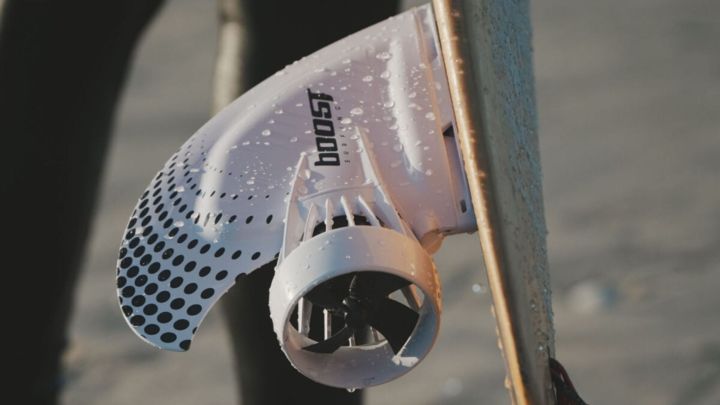
- Configuración rápida y sencilla: Se adapta a cualquier tabla de longboard, shortboard o paddleboard en solo 5 minutos. Puedes seguir usando tu tabla favorita y seguir disfrutando de las ventajas de Boost Fin.
- Atrapa más olas: Podrás mejorar tu selección y posicionamiento de olas y surfear olas que normalmente no podrías con velocidades de 10 mph, convirtiendo la captura de olas en una experiencia emocionante.
- Navega por más tiempo: Dile adiós a esas sesiones de surf demasiado cortas. Con la impresionante duración de la batería de Boost Fin de 60 a 90 minutos por carga, estás listo para viajes más largos.
Vista rápida de las especificaciones:
- Diseño liviano: Con solo 2,7 libras, no agregará peso innecesario a tu tabla.
- Materiales duraderos: Fabricado con polímero reforzado con fibra de vidrio y plástico ABS para mayor durabilidad.
- Batería potente: Equipado con una batería de iones de litio de alta calidad de 3500 mAh, 24 V, 84 Wh.
- Control remoto responsivo: Viene con un control remoto de 433 MHz para un control rápido y fácil.
Si bien las aletas eléctricas suelen tener un precio que va desde los 200 a los 1000 dólares, la aleta Boost se destaca por su precio asequible de tan solo 499 dólares. Obtendrás un complemento potente, duradero y rápido para tu tabla de surf, lo que hará que cada momento en el agua sea verdaderamente inolvidable.
La curva de aprendizaje del surf al descubierto
Aprender a surfear es un viaje gratificante y emocionante, pero también puede ser largo y desafiante.
Entonces, ¿Cuánto tiempo se tarda en aprender a hacer surf ? Bueno, es diferente para cada persona. Es una combinación de cuánto practicas, tu aptitud natural para el deporte y sí, el equipo que usas. Aquí es donde algo como el Aleta de refuerzo Entra en juego.
Permite a los surfistas principiantes y experimentados coger más olas, surfear durante más tiempo y acelerar su curva de aprendizaje. La integración de este tipo de tecnología avanzada en su práctica puede mejorar significativamente su eficiencia en el agua. Siga surfeando, sea constante en su práctica y descubrirá lo gratificante y progresivo que puede ser el camino hacia la competencia en el surf.


Compartir:
31 consejos de surf para principiantes que debes conocer
Etiqueta del surf: reglas básicas del surf